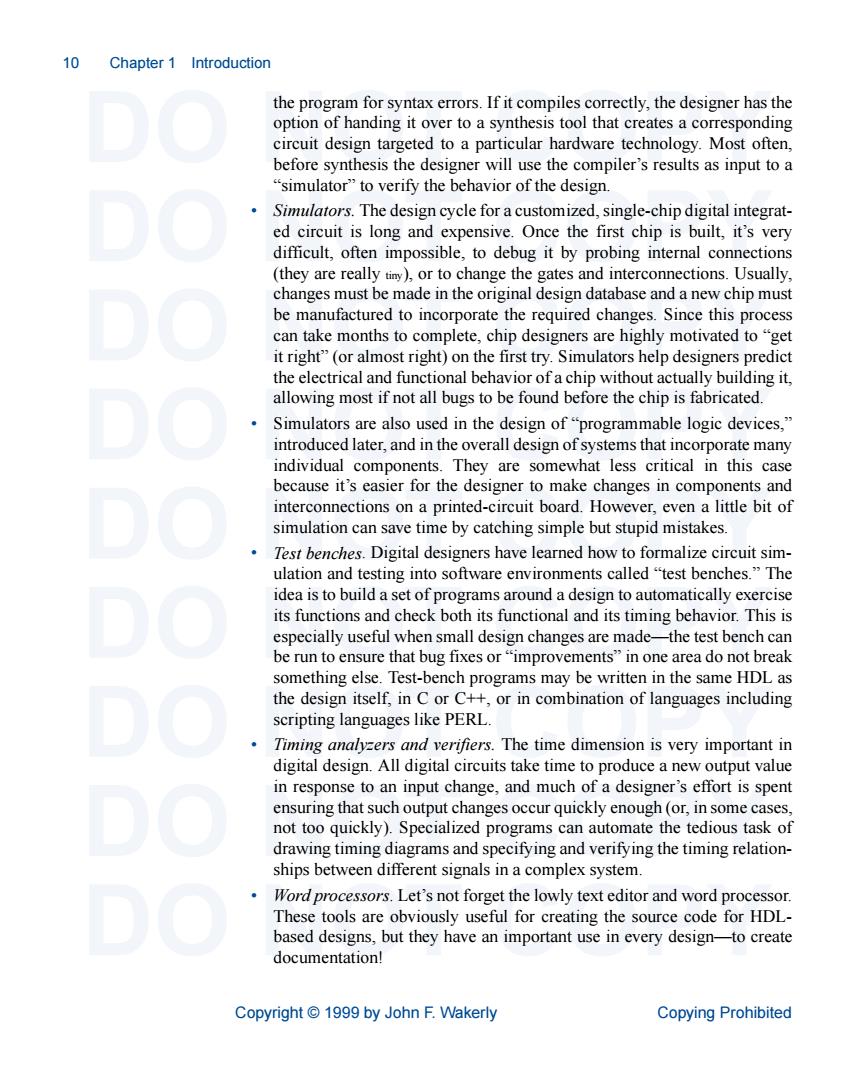正在加载图片...

10 Chapter 1 Introduction the program for syntax errors.If it compiles correctly,the designer has the optior of handing it over toasynthesis tool that creates a oresponding circuit design targeted to a particular hardware technology.Most often, before synthesis the designer will use the compiler's results as input to a "simulator"to verify the behavior of the design. Simulators.The design cycle for a customized,single-chip digital integrat- ed circuit is long and expensive.Once the first chip is built,it's very difficult,often impossible,to debug it by probing internal connections (they are really timy),or to change the gates and interconnections.Usually. changes must be made in the original design database and a new chip must be manufactured to incorporate the required changes.Since this process can take months to complete,chip designers are highly motivated to "get it right"(or almost right)on the first try.Simulators help designers predict the electrical and functional behavior of a chip without actually building it allowing most if not all bugs to be found before the chip is fabricated. Simulators are also used in the design of"programmable logic devices, introduced later,and in the overall design of systems that incorporate many individual components.They are somewhat less critical in this case because it's easier for the designer to make changes in comp nts and interconnections on a printed-circuit board.However,even a little bit of simulation can save time by catching simple but stupid mistakes. Test benches.Digital designers have learned how to formalize circuit sim- ulation and testing into software environments called "test benches."The idea is to build a set of progra ms around a design to automatically exercise its functions and check both its functional and its timing behavior.This is especially useful when small design changes are made-the test bench can be run to ensure that bug fixes or"improvements"in one area do not break something else.Test-bench programs may be written in the same HDL as the design itself,in C or C++,or in combination of languages including scripting languages like PERL. Timing analyzers and verifiers.The time dimension is very important in digital design.All digital circuits take time to produce a new output value in response to an input change,and much of a designer's effort is spent ensuring that such output changes occur quickly enough(or,in some cases. not too quickly).Specialized programs can automate the tedious task of drawing timing diagrams and specifying and verifying the timing relation ships between different signals in a complex system. Wordprocessors.Let's not forget the lowly text editor and word processor These tools are obviously useful for creating the source code for HDL- based designs,but they have an important use in every design-to create documentation! Copyright 1999 by John F.Wakerly Copying Prohibited 10 Chapter 1 Introduction DO NOT COPY DO NOT COPY DO NOT COPY DO NOT COPY DO NOT COPY DO NOT COPY DO NOT COPY DO NOT COPY DO NOT COPY Copyright © 1999 by John F. Wakerly Copying Prohibited the program for syntax errors. If it compiles correctly, the designer has the option of handing it over to a synthesis tool that creates a corresponding circuit design targeted to a particular hardware technology. Most often, before synthesis the designer will use the compiler’s results as input to a “simulator” to verify the behavior of the design. • Simulators. The design cycle for a customized, single-chip digital integrated circuit is long and expensive. Once the first chip is built, it’s very difficult, often impossible, to debug it by probing internal connections (they are really tiny), or to change the gates and interconnections. Usually, changes must be made in the original design database and a new chip must be manufactured to incorporate the required changes. Since this process can take months to complete, chip designers are highly motivated to “get it right” (or almost right) on the first try. Simulators help designers predict the electrical and functional behavior of a chip without actually building it, allowing most if not all bugs to be found before the chip is fabricated. • Simulators are also used in the design of “programmable logic devices,” introduced later, and in the overall design of systems that incorporate many individual components. They are somewhat less critical in this case because it’s easier for the designer to make changes in components and interconnections on a printed-circuit board. However, even a little bit of simulation can save time by catching simple but stupid mistakes. • Test benches. Digital designers have learned how to formalize circuit simulation and testing into software environments called “test benches.” The idea is to build a set of programs around a design to automatically exercise its functions and check both its functional and its timing behavior. This is especially useful when small design changes are made—the test bench can be run to ensure that bug fixes or “improvements” in one area do not break something else. Test-bench programs may be written in the same HDL as the design itself, in C or C++, or in combination of languages including scripting languages like PERL. • Timing analyzers and verifiers. The time dimension is very important in digital design. All digital circuits take time to produce a new output value in response to an input change, and much of a designer’s effort is spent ensuring that such output changes occur quickly enough (or, in some cases, not too quickly). Specialized programs can automate the tedious task of drawing timing diagrams and specifying and verifying the timing relationships between different signals in a complex system. • Word processors. Let’s not forget the lowly text editor and word processor. These tools are obviously useful for creating the source code for HDLbased designs, but they have an important use in every design—to create documentation!